The birth of Diamond Back begins with the release of the first looptail model, encorporating a Euro bottom bracket and advertised as the 'MX'.
os-db.net: DiamondBack originated from the US in Southern California. It was a division of Western States Imports (WSI) and sister company to Centurion Bicycle Workshop who had been selling 10 speed bikes for the past ten or so years. Diamond Back was so called because Centurion thought the frame resembled two diamonds and snakes were 'kickin' The original frameset kits started to show up around the end in 1976, though manufacturing started in 1977 after early race testing and improvement recommendations by Wheels 'n Things. Their initial intention was to concentrate on getting the bike into the Californian market rather that national. When production started, early models were constructed by the same company who assembled FMF and SE using materials such as Chromoly and mild steel. The original forks were dual dropout copies of a race fork “speedo” because Sandy Finkelman liked their design and some early DiamondBack went with a similar format. Early bikes were more commonly known as just DiamondBack and not 'models' even though brochures advertise the 'very first' as MX.
MX FIRST GENERATION.
dbbmx.wordpress.com:
It was TriMoly and can be easily identified by its Euro Bottom Bracket and square brake bridge.
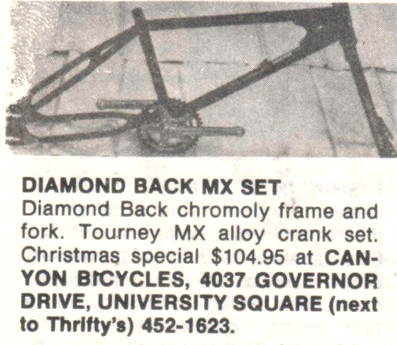
os-db.net: Release of the 2nd generation 'MX' with a variety of finishes available and upgraded to the more common US bottom bracket.
dbbmx.wordpress.com: It was still TriMoly but now offered a American Bottom Bracket.
MADE IN JAPAN.
os-db.net: In late 1978 manufacturing was moved to the Koizumi factory in Japan (which was probably due to the strength of trading overseas) with the launch of the early pro models, Small, Standard and Large, all Chromoly with Steel dropouts.
DIAMOND BACK PRO.
In 1979 they debuted the “Pro” an all 4130 bike.
DIAMOND BACK RADICAL REPTILE RACER.
dbbmx.wordpress.com: This is a press release from “Bicycle Motocross Action” appearing in the Feb. ’80 issue. It must therefore have been taken in late ’79. It also says the new Kit. I believe it was late ’79 for Christmas sales that Diamond Back introduced the bike kits. This would be the first ’80 model. Its kit had a SunTour stem. Suntour seat clamp, Alloy bars, Fluted alloy seat post, Kashimax MX seat, Shimano Tourney rear brake, 3 piece alloy cranks (could be SunTour maybe). The bike at first (Late 79) had no large DB seat tube decal.
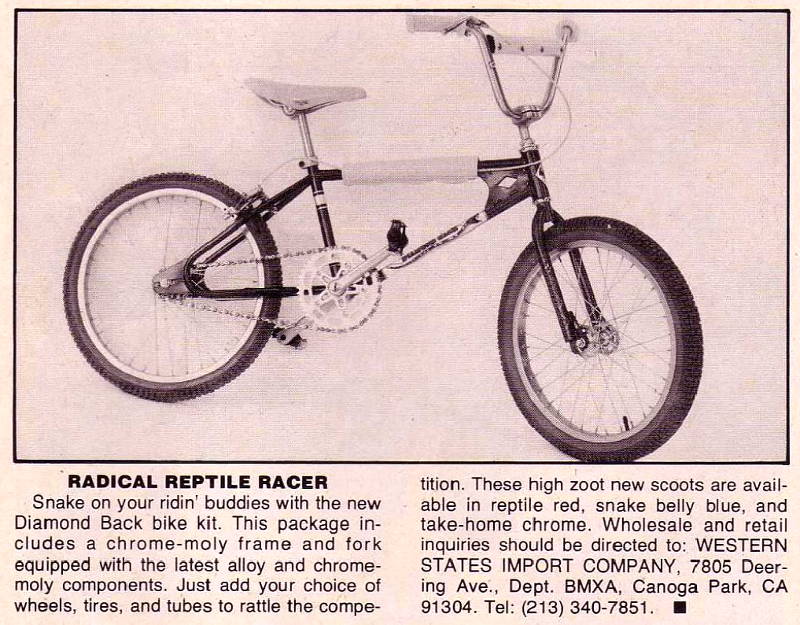
Test of the Diamond Back BMX, the first ever tested, in BMX Action january 1981.
os-db.net: It wasn't until 1981 when the more successful updated Pro range was available in Mini, Medium and Senior, or a custom Kit was available (all were full Chromoly framesets)
DIAMOND BACK MINI.
BMX ACTION.
Diamond Back's Scary Harry Leary on the cover of BMX Action november 1981.
DIAMOND BACK PRO.
Diamond Back Pro testing in BMX Action december 1981.
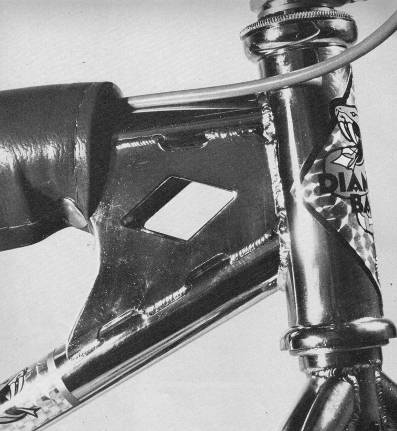
Harry Leary all kicked out on the cover of BMX Action january 1982.
os-db.net: With Harry Leary on board and design/development driven by Sandy Finkelman, the Senior Pro became the testing platform and benchmark for the later released Harry Leary signature 'Turbo' in mid 1982. Leary himself provided vast input into the Turbo since it was to be his signature model. Later that year cam the tri-moly Silver Streak, similar geometry to the medium pro, but a mild steel rear triangle and slightly thicker dropouts (steel).
os-db.net: In 1982 DiamondBack had already commisioned Akisu (Taiwan) to produce a low end model, the Pro-Star and with the economic climate weakening in the US by late 1983, some model production was moved to Akisu, these being the Pro-Star replacement Viper and Pacer 500. Higher end styles such as the Formula One and 2nd generation Harry Leary continued to be manufactured in Japan, but the original "large diamond" gusset underwent a facelift (as did the Harry Leary ) and were replaced by a noticeably smaller diamond/gusset amoungst other changes.
os-db.net: DiamondBack dropped the Pacer, fearing the name was the main reason for reduced BMX sales and decided to continue with the highly successful Viper, hence the Super Viper, which was primarily a Pacer 500 frame and forks and the last of the looptail frames.
DIAMOND BACK SILVER STREAK.
Test in BMX Action february 1983 and BMX Action Bike april 1982.
TURBO.
Test of a Diamond Back Turbo in BMX Action september 1982 and BMX Torke march 1983.
os-db.net: Sandy had just finalised his previous project, the Formula One and a very questionable replacement to the Silver Streak was launched.
DIAMOND BACK VIPER.
Test in BMX Action Bike october 1983.
os-db.net: Diamond Back expanded their range somewhat, their lower end manufacturing continued to be manufactured by Akisu (Taiwan) and higher end models by Koizumi (Japan). There was also the overhauling of some existing models, noticeably the 'Harry Leary'... and who would have thought Diamond Back would drop a name due to poor sales, bye-bye 'Pacer 500'.
There were also some framesets decalled up as 'VIPER' on the chainstay, which were primarily Pacer 500 / Super Viper framesets, had an 'ABA No.1Factory Team Diamond Back' decal for the Seatstay and a 'CHROMO MAIN TUBES' decal on the seat post tube. Official literature about these model is somewhat lacking so I've used images sourced from searches.
1984 starts to see an almost waywood direction for DB.
DIAMOND BACK FORMULA ONE.
Testing the Diamond Back Formula One in BMX Action may 1984.
HARRY LEARY.
Lookback on the cover of BMX Action july 1984. Photo by Jim Cassinus.
TURBO.
Test of a Diamond Back Turbo in BMX Action october 1984.
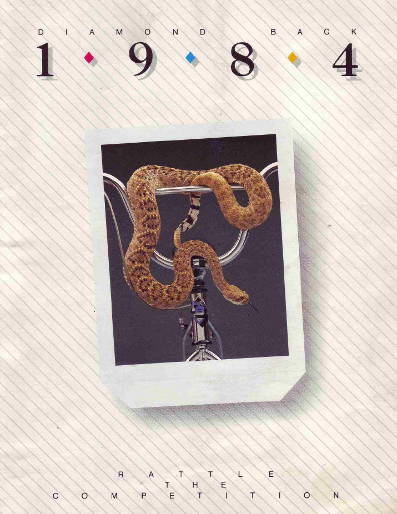
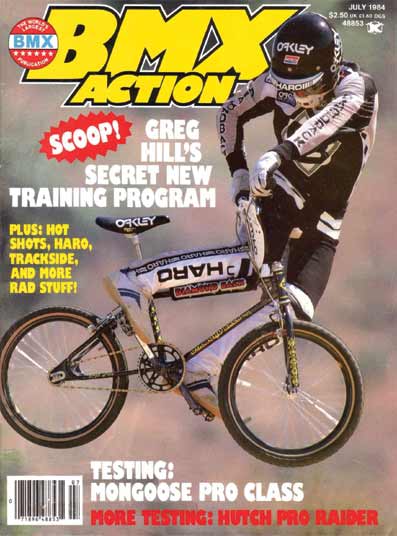
SUPER VIPER.
Tests on a Diamond Back Super Viper with Harry Leary in BMX Action february 1985.
Diamond Back Super Viper test in BMX Action september1986.
SUPER STREAK.
Testing Diamond Back Super Streak in BMX Action july 1985 and BMX Plus! january 1985.
HOT STREAK.
Testing Diamond Back Hot Streak in BMX Plus! november 1985.
STRIKE ZONE.
Diamond Back Mike Dominguez Strike Zone test in American Freestyler september 1987.
Diamond Back Strike Zone Test with Mike Dominguez as test rider in Freestylin october 1986.
BICROSS MAGAZINE.
Mike Dominguez on the cover of Bicross magazine december 1986.
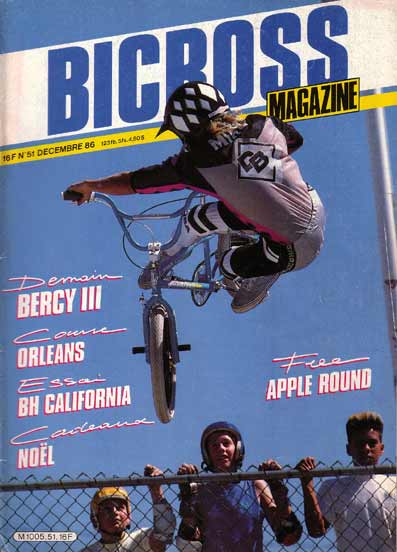
Bicross Magazine, mars 1987: WSI, la maison mère de Diamond Back est le deuxième groupe US en volume de ventes.
Diamond Back Reactor bike test in BMX Action may 1988.
BMX Action, january 1988: Diamond Back's new top'o the line race bike is called the Reactor. This bike replaces the Harry Leary Turbo model.
WOODY ITSON STRIKE ZONE.
Woody Itson worked with Diamond Back to come up with an all-new freestyle frame design. They introduced it as the Woody Itson Strike Zone and started selling them early 1988.
Sampling: Diamond Back Woody Itson Strike zone in Freestylin june 1988.
DIAMOND BACK DROPS MIKE DOMINGUEZ.
Diamond Back has sent Mike Dominguez a letter informing the 1987 AFA Pro Ramps champ that they have terminated his sponsorship due to contract violations on his part. Among the offenses of which he was accused, Diamond Back cited Mike for wearing Haro pants in a contest, using a Hutch stem on his bike, not being a team player, and allowing his phone to remain disconnected for an extended period of time.
CANCELLED SUMMER TOUR.
Diamond Back has canceled their plans for their summer freestyle tour. Thirty shows were booked, but the goal was 50, according to Woody Itson. So the company decided to drop the plans. The company's dissatisfactions with Dominguez might have had something to do with the decision.
HOT STREAK.
Diamond Back Hot Streak test in Freestylin february 1989.
Bike test: Diamond Back Reactor Pro in Ride BMX UK february 1996.
December 2000, Bruce Crisman signs with Diamond Back.
Bruce: Scott Matual, the team manager gave me a call and we pretty much worked things from there. They understand the fact that I like to ride a custom bike... basically what I'm comfortable with, because I'm not just going to run anything that I don't trust my life with. They're pretty cool with that, they made me a custom frame... I run the frame and I run the pedals, seat, stuff like that.
Essai du Diamond Back Mister Lucky dans le BMX Air numéro 10.
Test: Diamond Back Reactor Pro in Transworld BMX january 2005.
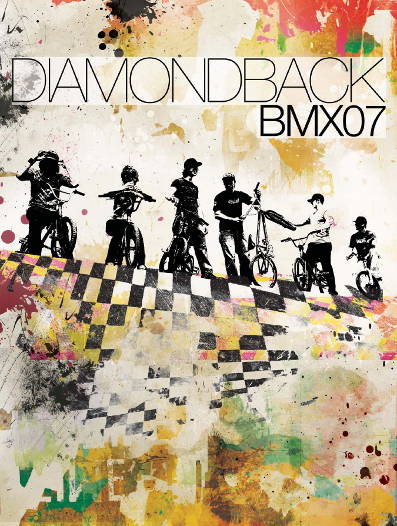
Bruce Crisman 2000, Scott Matual, the team manager gave me a call and we pretty much worked things from there. -2003
Mike Dominguez (1986 - 1988) Diamond Back has sent Mike Dominguez a letter informing the 1987 AFA Pro Ramps champ that they have terminated his sponsorship due to contract violations on his part.
Reuel Erickson 2002
Woody Itson 1987, Hutch had filed for bankruptcy and I was owed some money and had bills to pay and Mike Dominguez was on Diamond Back at the time and he asked me if I wanted to ride with him again, this time on DB, I said yes and spent my last sponsored years there.
Eddie King (1982-1983)
Harry Leary devient responsable commercial en 1988
Colin MacKay